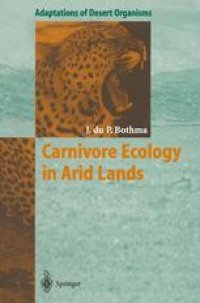
Ebook: Carnivore Ecology in Arid Lands
- Tags: Ecology, Zoology, Geoecology/Natural Processes, Nature Conservation
- Series: Adaptations of Desert Organisms
- Year: 1998
- Publisher: Springer-Verlag Berlin Heidelberg
- Edition: 1
- Language: English
- pdf
Arid lands require that organisms inhabiting them be well-adapted to thrive or even just to survive. This book provides a review of the ecological adaptations - be they behavioural, physiological or morphological - of carnivores to arid environments. Following a general introduction into aridity and arid lands in Africa, the major carnivore families are presented. Ecological adaptations of carnivores in arid lands reveal the amplitude and resilience of the ecology of these animals. In setting up conservation measures, the nature and extent of such adaptations are important facets in determining the effective area and degree of heterogeneity required as habitat by a carnivore population so as to produce a viable unit.
Arid lands require that organisms inhabiting them be well-adapted to thrive or even just to survive. This book provides a review of the ecological adaptations - be they behavioural, physiological or morphological - of carnivores to arid environments. Following a general introduction into aridity and arid lands in Africa, the major carnivore families are presented. Ecological adaptations of carnivores in arid lands reveal the amplitude and resilience of the ecology of these animals. In setting up conservation measures, the nature and extent of such adaptations are important facets in determining the effective area and degree of heterogeneity required as habitat by a carnivore population so as to produce a viable unit.
Arid lands require that organisms inhabiting them be well-adapted to thrive or even just to survive. This book provides a review of the ecological adaptations - be they behavioural, physiological or morphological - of carnivores to arid environments. Following a general introduction into aridity and arid lands in Africa, the major carnivore families are presented. Ecological adaptations of carnivores in arid lands reveal the amplitude and resilience of the ecology of these animals. In setting up conservation measures, the nature and extent of such adaptations are important facets in determining the effective area and degree of heterogeneity required as habitat by a carnivore population so as to produce a viable unit.
Content:
Front Matter....Pages I-X
Introduction....Pages 1-5
Family Canidae....Pages 7-42
Family Felidae....Pages 43-87
Family Hyaenidae....Pages 89-148
Family Herpestidae....Pages 149-165
Families Mustelidae and Viverridae....Pages 167-170
Synthesis....Pages 171-184
Back Matter....Pages 185-211
Arid lands require that organisms inhabiting them be well-adapted to thrive or even just to survive. This book provides a review of the ecological adaptations - be they behavioural, physiological or morphological - of carnivores to arid environments. Following a general introduction into aridity and arid lands in Africa, the major carnivore families are presented. Ecological adaptations of carnivores in arid lands reveal the amplitude and resilience of the ecology of these animals. In setting up conservation measures, the nature and extent of such adaptations are important facets in determining the effective area and degree of heterogeneity required as habitat by a carnivore population so as to produce a viable unit.
Content:
Front Matter....Pages I-X
Introduction....Pages 1-5
Family Canidae....Pages 7-42
Family Felidae....Pages 43-87
Family Hyaenidae....Pages 89-148
Family Herpestidae....Pages 149-165
Families Mustelidae and Viverridae....Pages 167-170
Synthesis....Pages 171-184
Back Matter....Pages 185-211
....
Download the book Carnivore Ecology in Arid Lands for free or read online
Continue reading on any device:

Last viewed books
Related books
{related-news}
Comments (0)